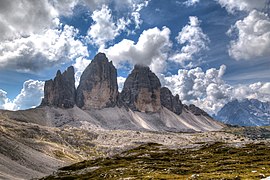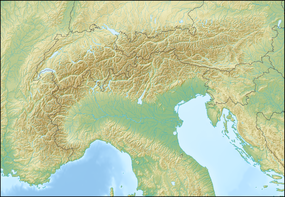
Back دولوميت (سلسلة جبلية) Arabic دولوميت ARZ Dolomites AST Dolomitn BAR Даламітавыя Альпы Byelorussian Доломити (планинска верига) Bulgarian ডলোমাইটস Bengali/Bangla Dolomitoù Breton Dolomites Catalan Dolomiti CEB
| Dolomites | |
|---|---|
| Italian: Dolomiti Ladin: Dolomites German: Dolomiten | |
 Valley of Funes, 2024 | |
| Highest point | |
| Peak | Marmolada |
| Elevation | 3,343 m (10,968 ft) |
| Coordinates | 46°26′N 11°51′E / 46.433°N 11.850°E |
| Dimensions | |
| Area | 15,942 km2 (6,155 sq mi) |
| Geography | |
| Country | |
| Regions | |
| Parent range | Alps |
| Geology | |
| Orogeny | Alpine orogeny |
| Rock age | Mostly Triassic |
| Rock types | |
| UNESCO World Heritage Site | |
|---|---|
 | |
| Criteria | Natural: (vii)(viii) |
| Reference | 1237 |
| Inscription | 2009 (33rd Session) |
| Area | 141,902.8 ha |
| Buffer zone | 89,266.7 ha |
The Dolomites (Italian: Dolomiti [doloˈmiːti]),[1] also known as the Dolomite Mountains, Dolomite Alps or Dolomitic Alps, are a mountain range in northeastern Italy. They form part of the Southern Limestone Alps and extend from the River Adige in the west to the Piave Valley (Pieve di Cadore) in the east. The northern and southern borders are defined by the Puster Valley and the Sugana Valley (Italian: Valsugana). The Dolomites are in the regions of Veneto, Trentino-Alto Adige/Südtirol and Friuli-Venezia Giulia,[2] covering an area shared between the provinces of Belluno, Vicenza, Verona, Trentino, South Tyrol, Udine and Pordenone.
Other mountain groups of similar geological structure are spread along the River Piave to the east—Dolomiti d'Oltrepiave; and far away over the Adige River to the west—Dolomiti di Brenta (Western Dolomites). A smaller group is called Piccole Dolomiti (Little Dolomites), between the provinces of Trentino, Verona and Vicenza.
The Dolomiti Bellunesi National Park and many other regional parks are in the Dolomites. On 26 June 2009, the Dolomites were declared a UNESCO World Heritage Site.[3][4] The Adamello-Brenta UNESCO Global Geopark is also in the Dolomites.[5] The Geological Museum of the Dolomites (in Italian Museo Geologico delle Dolomiti) is located in Predazzo, Fiemme Valley.
- ^ Ladin: Dolomites; German: Dolomiten [doloˈmiːtn̩] ("Dolomiten" in Langenscheidt German-English Dictionary); Venetian: Dołomiti [doɰoˈmiti]: Friulian: Dolomitis
- ^ "Dolomiti, le montagne rosa". italia.it (in Italian). Archived from the original on 2021-11-29. Retrieved 2020-07-02.
- ^ "The Dolomites UNESCO World Heritage Site". Dolomites UNESCO World Heritage (in English, German, and Italian). Archived from the original on 4 February 2024. Retrieved 4 May 2024.
- ^ "The Dolomites". UNESCO (in English, French, Arabic, Spanish, Japanese, and Dutch). Archived from the original on 25 April 2024. Retrieved 4 May 2024.
- ^ "Adamello-Brenta UNESCO Global Geopark". Retrieved 17 January 2023.
